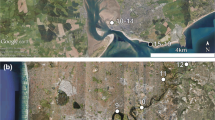Abstract
Data collected from a survey of the benthic fauna of Liverpool Bay (UK) have been used to study the distribution and structure, in terms of percent age dominance and percent age frequency, of the nematode populations. Cluster analysis of the faunistic data from individual stations has shown that the populations are not sharply delimited. The relative proportions of their characteristic genera are extremely variable, and apparently influenced by small differences in sediment composition. It is, thus, considered more logical to think in terms of a number of different habitats, each with certain characteristic genera, rather than in terms of a series of discrete associations. Six types of habitat are distinguished on the basis of sediment granulometry: (1) mud and sandy mud; (2) very muddy sand; (3) muddy sand; (4) muddy sand-gravel mixtures; (5) clean sand-gravel mixtures; (6) clean sand. Habitats 1, 2 and 3 were dominated by Sabatieria spp., the degree of dominance apparently being related to the percentage of silt-clay. Habitat 4 was dominated by Neochromadora sp. and Sabatieria spp. and Habitats 5 and 6 by Desmodora sp. Both generic and dominance diversity were very much lower for Habitats 1 and 2 than elsewhere.
Similar content being viewed by others
Literature Cited
Crickmore, M. J. and P. R. Kiff: Bed sediments: particle size. In: Out of sight out of mind; report of a working party on slidge disposal in Liverpool Bay, Vol. 2. Appendix 12. pp 273–286. London: Her Majesty's Stationary Office 1972.
Field, J. G. and G. McFarlane: Numerical methods in marine ecology. I. A quantitative “similarity” analysis of rocky shore samples in False Bay, South Africa. Zoologica african. 3, 119–137 (1968).
Fisher, R. A., A. S. Corbet and C. B. Williams: The relation between the number of species and the number of individuals in a random sample from an animal population. J. Anim. Ecol. 12, 42–58 (1943).
Ford, E.: Animal communities of the level sea bottom in the waters adjacent to Plymouth. J. mar. biol. Ass. U.K. 13, 164–224 (1923).
Gerlach, S. A.: Die Biozönotische Gliederung der Nematodenfauna an den Deutschen Küsten. Z. Morphol. Ökol. Tiere 41, 411–512 (1953).
—: Die Nematodenfauna der sublitoralen Region in der Kieler Bucht. Kieler Meeresforsch. 14, 64–90 (1958).
Gleason, H. A.: On the relation between species and area. Ecology 3, 158–162 (1922).
Hessler, R. R. and H. L. Sanders: Faunal diversity in the deepsea. Deep Sea Res. 14, 65–78 (1967).
Hopper, B. E. and S. P. Meyers: Population studies on benthic nematodes within a subtropical seagrass community. Mar. Biol. 1, 85–96 (1967).
Jones, N. S.: Marine bottom communities. Biol. Rev. 25, 283–313 (1950).
Lloyd, M. and R. J. Ghelardi: A table for calculating the “equitability” component of species diversity. J. Anim. Ecol. 33, 217–225 (1964).
MacArthur, R. H.: On the relative abundance of bird species. Proc. natn. Acad. Sci. U.S.A. 43, 293–295 (1957).
Margalef, R.: La teoria de la información en ecologia. Mems R. Acad. Cienc. Artes Barcelona 33, 373–449 (1957).
McIntyre, A. D.: Quantitative differences in the fauna of boreal mud associations. J. mar. biol. Ass. U.K. 41, 599–616 (1961).
Mountford, M. D.: An index of similarity and its application to classificatory problems. In: Progress in soil zoology, pp 43–50. Ed. by P. W. Murphy. Butterworth 1962.
Preston, F. W.: The commonness and rarity of species. Ecology 29, 254–283 (1948).
Raabe, E. W.: Über den ‘Affinitätswert’ in der Pflanzensoziologie. Vegetatio 4, 53–68 (1952).
Rees, E. I. S., A. J. M. Walker and A. R. Ward: Benthic fauna in relation to sludge disposal. In: Out of sight out of mind; report of a working party on sludge disposal in Liverpool Bay, Vol. 2. Appendix 14. pp 297–343. London: Her Majesty's Stationary Office 1972.
Sanders, H. L.: Marine benthic diversity: a comparative study. Am. Nat. 102, 243–282 (1968).
Simpson, E. H.: Measurement of diversity. Nature, Lond. 163, p. 688 (1949).
Sly, P. G.: Marine geological studies in the eastern Irish Sea and adjacent estuaries, with special reference to sedimentation in Liverpool Bay and River Mersey. Thesis to University of Liverpool (UK) 1966.
Warwick, R. M. and J. B. Buchanan: The meiofauna off the coast of Northumberland. I. The structure of the nematode population. J. mar. biol. Ass. U.K. 50, 129–146 (1970).
Whittaker, R. H.: Dominance and diversity in land plant communities. Science, N.Y. 147, 250–260 (1965).
Wieser, W.: Free-living marine nematodes. IV. General Part. Chile Reports 34. Acta Univ. lund (N.F. Avd. 2) 55 (5), 1–111 (1959a).
—: Free-living nematodes and other small invertebrates of Puget Sound beaches. Univ. Wash. Publs Biol. 19, 1–179 (1959b).
—: Benthic studies in Buzzards Bay II. The meiofauna. Limnol. Oceanogr. 5, 121–137 (1960).
Author information
Authors and Affiliations
Additional information
Communicated by J. H. S. Blaxter, Oban
Rights and permissions
About this article
Cite this article
Ward, A.R. Studies on the sublittoral free-living nematodes of Liverpool Bay. I. The structure and distribution of the nematode populations. Marine Biology 22, 53–66 (1973). https://doi.org/10.1007/BF00388910
Accepted:
Issue Date:
DOI: https://doi.org/10.1007/BF00388910




